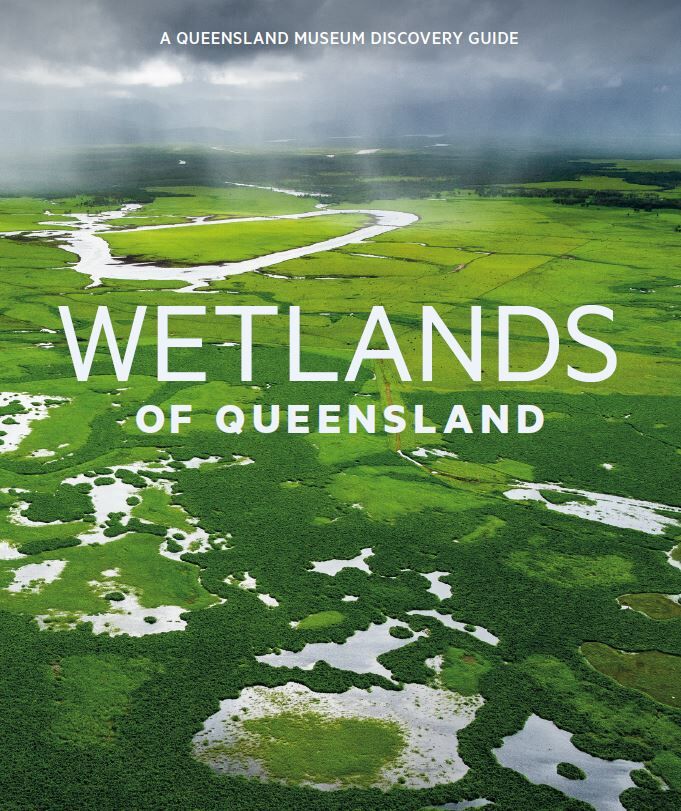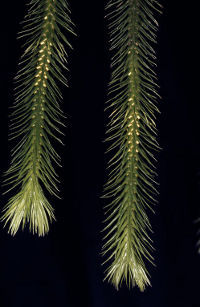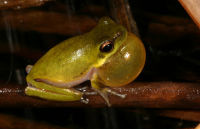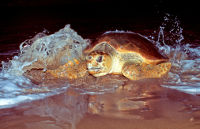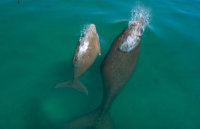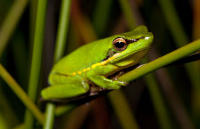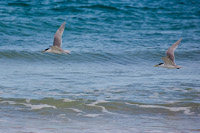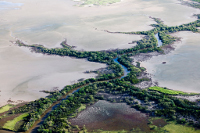|
|
What are wetlands?When we think of wetlands we often think of the local swamp or low lying area near the coast, but wetlands are much more than that. Swamps, marshes, billabongs, lakes, saltmarshes, mudflats, mangroves, coral reefs, fens and peat bogs are wetlands. Queensland even has underground wetlands, e.g. in the Chillagoe caves, west of the Atherton Tableland. Put simply, almost anywhere that can be wet is a wetland, as long as it has plants, animals or soil types that are adapted to wet conditions. Further informationWhat’s wonderful about wetlands?Wetlands support Queensland’s primary industries—saltmarsh, mangrove and seagrass wetlands provide nurseries for fish and seafood to grow. Some wetlands provide water for irrigation and farm animals. Wetlands can protect people and property from the effects of extreme climate events such as storm surges and floods; they even store carbon that has been released as greenhouse gas. Wetlands are also diversity hotspots for plants and animals, including threatened animals such as the dugong, little tern, wallum sedge frog and loggerhead turtle. Rare plants such as the feather palm and the blue tassel fern are only found in Queensland’s wetlands. Migratory shorebirds visit Queensland’s wetlands every year from as far away as China, Alaska and Siberia. Wetlands connect sections of the landscape to allow animal and plant species to move and spread from place to place to maintain their populations. Healthy wetlands are also places to relax and enjoy some of Queensland’s natural wonders. Some wetlands are recognised as internationally and nationally important, but even a local lake can be an important ecosystem that provides habitat for animals and plants, and connects land and water ecosystems. Currawinya Lakes hosts over 200 bird species with counts of over 100,000 individual birds recorded in and around its waters! Wetlands are valuable for our environment, our food, our fun and our culture. A healthy wetland is a lively place with a rich natural diversity of wildlife and environments. Chemical changes and the life cycles of wetland plants and animals combine to create a system that removes sediments and stops chemicals getting into healthy rivers, the sea and the reef. Where are our wetlands?Queensland wetlands are found from the Gulf of Carpentaria to the Gold Coast, and west from the coast to the semi-arid south west corner of the state. Queensland has more types of wetlands than any other state in Australia, including more seagrass meadows, mangrove forests and tea tree swamps. Most freshwater wetlands in Queensland are on private property. You will need the landholder’s permission before you can visit. However, many wetlands that are managed by local councils or catchment groups are open to the public. Ramsar wetlandsIn 1971, representatives from 18 nations including Australia met in the Iranian city of Ramsar to sign the Convention on Wetlands of International Importance, known as the Ramsar Convention. The Ramsar Convention aims to stop wetlands being lost across the world, and to conserve and manage the remaining wetlands we have. The convention also lists wetlands that are so valuable they are considered international treasures. They support large numbers of waterbirds and/or threatened species, exhibit other biodiversity or have unusual and precious landscapes. Queensland has 5 wetlands listed by the Ramsar Convention. All of these wetlands can be visited, except parts of Shoalwater Bay that are managed by the Department of Defence. Wetlands and cultureWetlands supply resources such as food, medicine and tools for Traditional Owners. Big river red gums or coolabahs scarred by shield and bowl makers of the past still stand along the edges of some Queensland wetlands. Wetlands are also story places and centres for cultural activity. The wetlands of Corio Bay, for example, are part of the traditional lands of the Darumbal people. Shell middens, scatters of stone tools and dinner camp sites can be found in the local dune fields. Did you know that the billabong in the song ‘Waltzing Matilda’ is a Queensland wetland? The Combo Waterhole on the Diamantina River north of Winton is generally accepted as the setting for the jolly swagman’s defiant last stand. Wetlands, shorebirds and other waterbirdsQueensland's wetlands provide habitat for shorebirds and other waterbirds. Some birds live here all year round; others migrate thousands of kilometres to this destination for a few months of the year. Migratory birds fly along routes known as 'flyways'. There are 8 flyways around the world which link chains of wetlands where travelling birds stop to eat and rest on their long migrations. Some birds' journeys last as long as 2 months. Australia lies at the southern end of the East Asian–Australasian Flyway which originates in Alaska and Russia and crosses 22 countries. Moreton Bay is an important destination on the East Asian–Australasian Flyway. More than 30,000 shorebirds from about 28 species migrate to Moreton Bay every year. During its flight from Siberia to Australia, the eastern curlew will burn off 40% of its weight to fuel its 13,000km journey. This is like an 80kg person running 16 million kilometres almost non-stop and losing 32kg—twice a year. Should we worry about the health of our wetlands?Some wetlands are less healthy than they once were because they have lost animals or plants that once lived there. Other wetland systems are no longer working naturally because human activity has changed the way water flows in or out of them. A damaged wetland can become a healthy system again with careful rehabilitation. However, once a wetland is drained or built on, it is lost forever. Some river catchments or basins in Queensland have lost most of their wetlands, particularly their bogs and swamps. What can threaten a wetland? Development, earthworks, draining and water extraction can all harm or destroy a wetland; so can the impacts of climate change or poor agricultural practices. Feral animals such as cane toads and invasive plants spreading into a wetland can kill or overwhelm local species and upset the wetland's natural balance. Uncontrolled fires can damage wetland plants; wetland peat soils can continue to burn long after the fire is extinguished on the surface. Who’s looking after our wetlands? Many groups take responsibility for looking after wetlands. The Australian and the Queensland governments create laws to protect vegetation and some special regions of wetlands. Local government planning controls help protect local wetlands. Catchment and conservation groups and natural resource groups restore and maintain local wetlands. Landholders, farmers and land managers can manage wetlands wisely. Local wetlands centres tell visitors about the values of wetlands and encourage us to enjoy the recreational benefits of wetlands, such as bird watching or nature walking. Many tourism operators promote wetlands to local and overseas tourists. Wetlands and youLet’s keep our wetlands healthy, so everyone can enjoy them. Here’s what you can do:
Wetland on-line education modules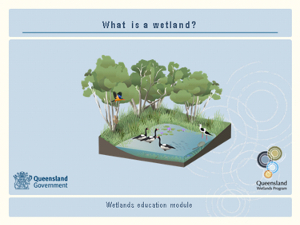 A series of on-line education modules, including What is a wetland?, has been prepared as a resource for people who want to learn more about wetlands. Users can download and use the contents of this education module to meet their learning and training needs. This information should be used in conjunction with information found on this website. This resource outlines the key principles of a wetland definition and should not be used for statutory purpose. Wetland WanderWetland Wander is an art-science collaboration led by wetland ecologist Fernanda Adame, sound artist Leah Barclay, walking/media artist James Cunningham, and multimedia artist Suzon Fuks. It incorporates knowledge from current and traditional landowners within Quandamooka (Moreton Bay), and Nywaigi, Gulgnay and Girramay countries (North Queensland). The rationale for the exhibition was that Wetland Wander aims to inspire engagement in the environmental, cultural and aesthetic values of wetlands and conservation of these critical ecosystems. Brochures and posters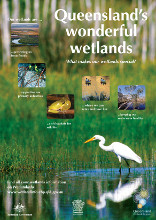
Download the Queensland’s wonderful wetlands brochure and poster or other posters and brochures available for your use. Order bulk print copies of the brochure (20 or more only) or poster (available in A3 and A2) by email.  Wetlands of the Great Barrier Reef catchments This brochure promotes the values of the wetlands in the catchments of the Great Barrier Reef. It promotes wise management of wetlands vital for protecting the world recognised values of the Great Barrier Reef. As many wetlands are located on private property, the brochure encourages a ‘working in partnership with landowners’ theme to achieve best outcomes. 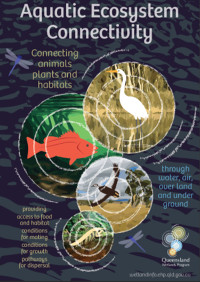 Aquatic ecosystem connectivity poster This poster promotes the importance of aquatic ecosystem connectivity and introduces some of the main issues to be considered. 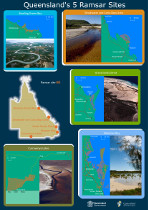 Poster showing Queensland's 5 Ramsar sites Print out this poster showing Queensland’s five Ramsar sites. The Ramsar Convention encourages the designation of sites containing representative, rare or unique wetlands, or wetlands that are important for conserving biological diversity. Australia was one of the first signatories. Find out more about our wetlands of international importance. Wetlands Reef Beat seriesThe Great Barrier Reef Marine Park Authority's Reef Beat education series encourages teachers and students to explore the amazing Great Barrier Reef, threats to the Reef, ways to protect the health and resilience of the Reef, and the people who are working together today to help protect the Reef for tomorrow. Australia’s amazing wetlandsThe Commonwealth Department of Sustainability, Environment, Water, Population and Communities has produced a brochure on Australia’s amazing wetlands, full of interesting information and links to more information and resources for students. Additional informationPoster: The Ramsar Strategic Plan 2016–24 For more information you can also contact us using the feedback button below. Pages under this sectionLast updated: 25 January 2021 This page should be cited as: Department of Environment, Science and Innovation, Queensland (2021) What are wetlands?, WetlandInfo website, accessed 8 May 2025. Available at: https://wetlandinfo.des.qld.gov.au/wetlands/what-are-wetlands/ |

 — Department of the Environment, Tourism, Science and Innovation
— Department of the Environment, Tourism, Science and Innovation

